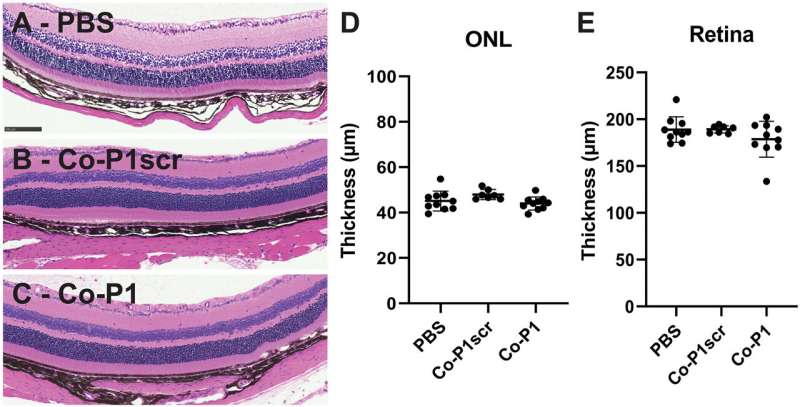This article has been reviewed according to Science X's editorial process and policies. Editors have highlighted the following attributes while ensuring the content's credibility:
fact-checked
peer-reviewed publication
trusted source
proofread
Protein-like polymers illuminate the path to macular degeneration treatment

In the latest stride toward combating neovascular age-related macular degeneration (nAMD), a team led by Professor Nathan Gianneschi from the International Institute for Nanotechnology at Northwestern University has unveiled a novel approach that could transform patients' lives worldwide.
Their research, published in Science Advances, introduces Thrombospondin-1 mimetic protein-like polymers (TSP1 PLPs) as a potential game-changer in the fight against this leading cause of blindness.
Understanding the challenge: Neovascular age-related macular degeneration (nAMD)
Before delving into the innovation of Gianneschi and his team, it's crucial to comprehend the gravity of nAMD. This condition is the primary cause of blindness in developed nations, leaving millions grappling with deteriorating eyesight and a diminished quality of life. While effective for many, current treatments fall short for a significant portion of patients, highlighting the urgent need for alternative therapies.
"Some years ago, we were made aware of the fact that some patients do not respond to current therapeutics in conversations with Profs. Jeremy Lavine and Greg Schwartz in Ophthalmology at Northwestern, Feinberg School of Medicine. We formed a multidisciplinary team to tackle the problem by mimicking a protein with our polymer technology, hypothesized to play a key role in the necessary pathway," said Gianneschi.
Enter TSP1 proteomimetic polymers: A ray of hope
Gianneschi and his colleagues have invented proteomimetic polymers, synthetic compounds engineered to mimic the behavior of natural proteins, as a potential solution. Their study centers around Thrombospondin-1 (TSP1), a protein known for inhibiting angiogenesis and forming new blood vessels. In nAMD, abnormal angiogenesis contributes to vision loss. By designing TSP1 PLPs, the researchers aimed to harness the power of this natural anti-angiogenic agent in a groundbreaking manner.
Their nano-size scale sets TSP1 PLPs apart, making them incredibly efficient at targeting specific cellular processes, much like an antibody, but manmade. By binding with CD36, a key player in angiogenesis regulation, these proteomimetic polymers interfere with the abnormal blood vessel formation characteristic of nAMD. Their diminutive size enables them to navigate the intricate ocular environment.
"Our polymers, act to engage the key receptor in a multivalent manner. This is similar to how we grab things with our entire hand instead of with one finger. It means we can hold on tight. The PLPs do this, but at cellular receptors at the back of the eye," said Gianneschi.
Moreover, these nano marvels demonstrate remarkable selectivity, stability, and longevity within the eye, ensuring a sustained therapeutic effect. Their nano-scale dimensions enhance their biological interactions and pave the way for minimally invasive delivery methods, promising improved patient comfort and outcomes.
Gianneschi and his team's work highlights the transformative potential of nanotechnology in medicine. By leveraging the principles of nanoscience, researchers are not only unraveling the complexities of biological systems but also engineering solutions that were once relegated to the realm of science fiction. Gianneschi's TSP1 PLPs represent a testament to the remarkable progress made in the field, offering a glimpse into a future where nanoscale innovations redefine the landscape of medical treatments.
More information: Wonmin Choi et al, Thrombospondin-1 proteomimetic polymers exhibit anti-angiogenic activity in a neovascular age-related macular degeneration mouse model, Science Advances (2023). DOI: 10.1126/sciadv.adi8534
Journal information: Science Advances
Provided by Northwestern University



















